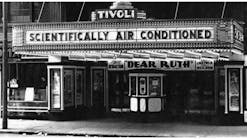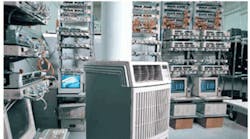Most engineers are well-aware of the "K.I.S.S." principle. This somewhat tongue-in-cheek saying, which stands for, "keep it simple, stupid," states that most mechanical systems will work best if kept simple, rather than complex. It applies nicely to the cooling of data centers and server rooms.
Excess heat is an ongoing concern in these facilities. Although a range of specialized installed equipment is available for such applications, including precision cooling and split systems, portable air conditioners (also known as "spot coolers") often can provide simple and flexible solutions at a fraction of the cost of permanent equipment. The K.I.S.S. method applies to the design of portable air conditioning equipment as well. The fewer the number of components, the less the chance of failure, as there are fewer things to go wrong or fail.
Today, a server room that once filled an entire building may be the size of a closet. The amount of heat generated by operating so much equipment in a small area poses difficult cooling challenges year-round. During summer, the cooling capacity of the central HVAC system usually is not sufficient to combat the high density server heat generated by information-technology (IT) equipment, especially during heat waves. During winter, the problem still exists in many facilities because of the lack of cooling equipment functionality and high ambient temperatures from heating the occupied space.
The trend toward server consolidation, which creates increasingly higher concentrations of electronics within tightly confined spaces, contributes further to the challenge. In tandem with consolidation, companies are striving to make data-center designs more flexible to allow for growth or change in the future.
It is vital to keep server-room temperatures at 68°F to 72°F, and relative humidity between 40 percent and 55 percent to prevent failure and maximize the life of IT equipment. Humidity control used to be even more critical, but improvements in hardware insulation have minimized electrostatic discharge and virtually eliminated electrical short circuits attributed to moisture buildup on hardware.
Overcome the 'Temporary' Misconception
How can portable air-conditioning equipment help HVAC engineers apply the K.I.S.S. principle for server-room cooling? The first step is to overcome the misconception that “portable” is synonymous with "temporary." In fact, a portable cooler can run the gamut from short-term, emergency use to permanent installation. Here are the main applications involving server rooms and data centers:
Permanent cooling in leased spaces. Many server rooms are located in leased facilities where landlords restrict or prohibit the installation of permanent HVAC equipment. Even where HVAC upgrades are allowed, lessees are reluctant to invest in built-in air-conditioning equipment that will be left behind in the event of a move. Portable cooling provides a cost-effective solution: It allows tenants to get the cooling they need for as long as they need it. Portable units can be transported to a new location or returned to the cooling supplier as the situation warrants.
Short- or long-term portable cooling to save on capital expenditures. Operational-cost reduction is virtually a universal goal in today’s economy. Portable cooling equipment is available on a daily, weekly, monthly, or long-term rental basis to satisfy cooling requirements without the need for an unwanted capital expenditure. And when a company elects to purchase the equipment, a spot cooler can be much kinder to the pocketbook than a conventionally installed system. In fact, a portable air-conditioning unit used in a permanent server-room application typically costs only 20 percent to 30 percent as much as a non-portable system of similar capacity, while still performing the required function.
As an interesting sidelight, during winter, hot-air exhaust from a portable unit can be vented out of the computer room to heat a hallway outside, adding a green benefit.
- Supplemental cooling of rooms where heat loads have increased. Increased heat loads are a common event in server rooms, whether because of consolidation or expansion. Upgrading an installed HVAC system can be a costly proposition. Portables can bridge the gap, providing the needed supplemental cooling without the need for a large capital expenditure.
- Emergency backup. Portable coolers probably are best known for delivering emergency cooling in the event of a power outage or a primary cooling-system failure. Though rental units often are used for this purpose, some companies purchase one or more portable units to keep on hand for emergencies—especially for larger data centers. Portable units provide redundancy for installed cooling systems if a problem should occur, and can be called into action to maintain critical temperature and humidity control when primary HVAC equipment is down for service or repair.
- Nighttime and weekend temperature setback for energy savings. Although many facilities operate only during business hours, data rooms must remain online 24/7. It is a literal waste of energy and money to run an entire central building air-conditioning system around the clock just to keep a data room cool, yet this sometimes is what happens. A much more efficient approach is to install a portable cooling unit that is dedicated to the server room and set to operate when the central system is shut down or on nighttime or weekend setback. A portable air conditioner installed for this purpose quickly will pay for itself in HVAC energy savings vs. running the entire building central system.
System Sizing
When sizing portable cooling equipment, the rule of thumb is to plan on 3.413 Btuh per watt of power consumed in the space to be cooled. The total heat load will depend on a number of factors, including the presence of windows or other openings, the amount of insulation used, the size of the room, and how much cooling is being supplied by the existing central HVAC system. But the most important factor in determining the cooling capacity requirement for the space is to have an accurate reading of how many watts are being consumed in the space.
If the room uses an uninterruptable-power-supply (UPS) battery backup, you can take the maximum battery wattage and multiply by 3.413 Btuh to determine the "worst-case" cooling-capacity requirement for the space. Some larger UPS devices have a digital readout that specifies the total wattage being consumed by data-room equipment. This calculation should ensure that you will have adequate cooling capacity for a worst-case scenario, such as an extended heat wave or failure of the central system. It is not a bad idea to oversize portable equipment slightly to allow for these circumstances, as well as to prevent a spot cooler from becoming obsolete if you increase the heat load in a space.
The most common units of choice are the standard 110-volt models, which have a smaller footprint and can be quickly installed without an electrician.
Installation Scenarios
The next step is determining where to locate portable equipment for optimum performance and serviceability. Equipment location largely is dictated by floor-space constraints and where the hot air will be ducted. Will the unit be located inside or outside of the space to be cooled? This will have an impact on ducting and return air considerations.
Page 2 of 2
Installation Configurations
The most common installation configurations are:
- Unit inside the server room with single duct. In this scenario, a single duct coming from the top of the portable cooler dissipates hot air into the return-air plenum or out of the space. This approach is advantageous where there is a central air-conditioning system running in the building at all times. As you direct hot air out of the room, the air must be replenished. The room being cooled by the portable unit will receive additional cooling from the main central system because the portable unit will be drawing negative pressure.
- Unit inside the server room with dual ducts. As noted earlier, one of the greenest applications for portable equipment is supplemental cooling during night or weekend temperature setback. Here, a condenser plenum typically is used on a unit with an additional duct (i.e., there will now be two ducts instead of one going to the drop ceiling). This creates a closed-loop system that no longer draws in negative pressure from the surrounding space. With the door shut, the space can be cooled independently, resulting in significant energy savings.
- Unit outside the server room. If a server room is so tightly configured that there is no place to position a portable unit, the challenge is to find a way to get the return-and cold-air supply ducted in and out of the room. The usual solution is to cut small openings in the drywall to insert the ductwork and cover up holes with grilles. If the portable installation is temporary, alternative solutions may be available using flexible ducting.
Although installing a portable cooler in a data center is clearly not quite as simple as "Wheel it in, and turn it on," a portable still allows you to apply the K.I.S.S. principle. Precision cooling or split systems often necessitate openings in the roof or outer wall, as well as interior walls; the use of cranes and other equipment to install rooftop systems; the use of external copper piping that requires sweating and brazing; charging units with refrigerant; and/or, with split systems, installing the condensing unit in a viable outdoor location.
Additionally, because portable units are self-contained in a warmer environment where they always supply cold air, they are not subject to being locked out when cold temperatures shut down split systems to prevent liquid slugging and damage to compressors.
Maintenance Considerations
Wherever a portable unit is installed, you must make provisions for draining the condensate water generated by the cooling process. Condensate sometimes is collected in a self-contained bucket that must be emptied periodically, though sometimes this is not feasible for 24/7 operation. Sometimes, gravity-draining condensate is an option. But the most common application for 24/7 operation is the use of a condensate pump.
Be sure to consider seasonal factors as well. When winter arrives, close off any vents to the data center so that heat from the building’s central system cannot enter the area. Re-evaluate your data-center cooling requirements now that supplemental air conditioning from the building no longer is available, and readjust settings on the portable unit as needed.
All in all, portable cooling equipment requires very little maintenance—and when it does, it is easy to access and service. If repair is needed, you can bring in a new unit and wheel out the malfunctioning one without risk of setting off the fire-suppression system as sometimes occurs with stationary units.
Did you find this article useful? Send comments and suggestions to Senior Editor Ron Rajecki at [email protected].
Buddy Phillips is a regional manager with Atlas Sales & Rentals, Inc., a distributor of portable cooling and heating equipment. He holds a mechanical engineering degree from Purdue University and has 27 years of experience in the HVAC industry. For more information, e-mail [email protected].









